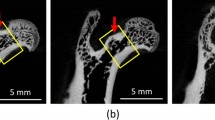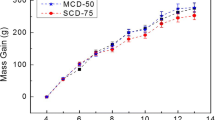Summary
In order to assess the repercussion of chronically affected parathyroid function on bone biomechanics, 3-point flexion tests were carried out with fresh, whole femurs of young, intact rats fed diets with low, normal, or high Ca contents, and thyroparathyroidectomized (TPTX) rats fed normal Ca diet. Ca-restriction reduced, and TPTX augmented, inertial parameters and load-resistance of the whole femurs, not affecting the bending stress or the modulus of elasticity of the bone material, suggesting that parathyroid status affected bone mass and architecture without biomechanical alteration of bone tissue. High-Ca feeding enhanced tissue strength and stiffness as a direct effect, not altering bone geometry. The relationships between the energy-absorbing capacity of the whole bones or of the bone tissue, and the moment of inertia of the fracture sections in weight-paired animals showed that (1) in intact rats under normocalcic diet, the inertia of the section was unrelated to the whole-bone biomechanical performance, while bone section architecture depended on bone tissue biomechanical quality; and (2) in the absence of the parathyroids, or in chronically-induced hyperparathyroidism, this last relationship did not apply, but section architecture had a major influence on the whole-bone biomechanics, independently of physiological stresses. The evidence obtained can be interpreted to indicate that architectural changes brought about by the parathyroids contribute to the regulation of bone biomechanics by adapting organ inertial parameters to tissue quality.
Similar content being viewed by others
References
Parfitt AM (1979) Quantum concept of bone remodeling and turnover: implications for the pathogenesis of osteoporosis. Calcif Tissue Int 28:1–5
Jurist JM, Folz AS (1977) Human ulnar bending stiffness, mineral content, geometry and strength. J Biomech 10:455–459
Noff D, Simkin A, Edelstein S (1982) Effect of cholecalciferol derivatives on the mechanical properties of chick bones. Calcif Tissue Int 34:501–505
Reilly DT, Burstein AH (1974) The mechanical properties of cortical bone. J Bone Joint Surg 56A:1001–1002
Currey JD (1969) The mechanical consequences of variation in the mineral content of bone. J Biomech 2:1–11
Bernhart FW, Tomarelli RM (1966) A salt mixture supplying the National Research Council estimates of the mineral requirements of the rat. J Nutr 89:499–500
Puche RC, Locatto ME, Ferretti JL, Fernández MC, Orsatti MB, Valenti JL (1976) The effect of long-term feeding of Solanum glaucophyllum to growing rats on Ca, Mg, P and bone metabolism. Calcif Tissue Res 20:105–119
Ferretti JL, Giuliani CA, Puche RC (1978) Influencias dietéticas y hormonales sobre la liberación de fosfatasa alcalina por el intestino de rata. Medicina (BA) 38:825–826
McCoy RH (1942) Dietary requirements of the rats. In: Griffith JQ, Farris EJ (eds) The rat in laboratory investigation. JB Lippincott, Philadelphia, pp 67–101
Ferretti JL, Bazán JL, Puche RC (1976) An analysis of an experimental model used in Ca−P metabolism studies: the rat housed in a metabolic cage. Medicine (BA) 36:83–92
Willis JB (1961) Determination of calcium and magnesium in urine by atomic absorption spectroscopy. Analyt Chem 33:556–559
Talmage RV, VanderWiel CJ (1979) The influence of calcitonin on the plasma and urine changes produced by parathyroid hormone. Calcif Tissue Int 28:113–119
King EJ, Armstrong AR (1934) A convenient method for determining serum and bile phosphatase activity. Can Med Ass J 31:376–381
Lappi VG, King MS, Le May I (1979) Determination of elastic constants for human femurs. J Biomech Eng 101:193–197
Ascenzi A (1980) Contribution of biomechanics to bone research. Calcif Tissue Int 31:1–3
Wall JC, Chatterji S, Jeffrey JW (1970) On the origin of scatter in results of human bone strength tests. Med Biol Eng 8:171–180
Evans FG (1973) Factors affecting the mechanical properties of bone. Bull NY Acad Med 49:751–764
Currey JD (1970) The mechanical properties of bone. Clin Orthop 73:210–231
Vose GP, Kubala AL (1959) Bone strength—its relationship to x-ray-determined ash content. Hum Biol 31:261–270
Wunder CC, Welch RC, Cook KM (1979) Femur strength as influenced by growth, bone length and gravity in the male rat. J Biomech 12:501–507
Bell GH, Cuthberson DP, Orr J (1941) Strength and size of bone in relation to calcium intake. J Physiol (Lond) 100:299–317
Snedecor GW, Cochran WG (1967) Statistical methods. Iowa State University Press, Iowa
Wolinsky I (1975) The mechanical strength of femurs of rats and mice fed a calcium-deficient diet. A differential species response. Comp Biochem Physiol 52:381–383
Yu WY, Siu CM, Shim SS, Hathorne HM, Dunbar JS (1975) Mechanical properties and mineral content of vascular and revascularizing cortical bone. J Bone Joint Surg 57:692–695
Rowland LO, Harms RH, Wilson HR, Ross IJ, Fry JL (1967) Breaking strength of chick bones as an indication of dietary calcium and phosphorus adequacy. Proc Soc Exp Biol Med 126:399–401
Amprino R (1958) Investigations on some physical properties of bone tissue. Acta Anat (Basel) 34:161–186
Currey JD (1969) The relationship between the stiffness and the mineral content of bone. J Biomech 2:477–480
Reutter F (1974) Diätetische Aspekte zur Osteoporose-Therapie. Schweitz Rundschau Med (PRAXIS) 63:1053–1056
Author information
Authors and Affiliations
Rights and permissions
About this article
Cite this article
Ferretti, J.L., Tessaro, R.D., Audisio, E.O. et al. Long-term effects of high or low Ca intakes and of lack of parathyroid function on rat femur biomechanics. Calcif Tissue Int 37, 608–612 (1985). https://doi.org/10.1007/BF02554917
Issue Date:
DOI: https://doi.org/10.1007/BF02554917




